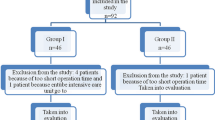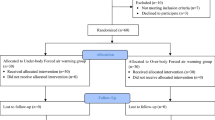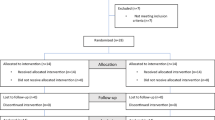Abstract
Intraoperative hypothermia is difficult to avoid and may present a significant clinical risk during the early postoperative phase. We evaluated a forced-air system [Bair Hugger, OR-type (BH)] for warming intraoperative patients with open abdominal surgery. Twenty patients received BH warming [BH(+) group] and another 20 patients, who served as controls, did not [BH(−) group]. Patients in both groups also received circulating blanket warming. Tempertures were measured at 30-min intervals throughout the operation in the rectum and on the tip of the index finger opposite the nail bed. The average operation time was 168.8±16.2 min. Rectal and fingertip temperatures in the BH(+) group were significantly higher than those in the BH(−) group, and central-peripheral temperature gradients in the BH(+) group were significantly smaller than those in the BH(−) group during the study, except at 180 min. No shivering occurred in either group. Therefore, BH is an effective warming device during open abdominal surgery.
Similar content being viewed by others
References
Flacke W (1963) Temperature regulation and anesthesia. Int Anesthesiol Clin 2:43–54
Vaughan RW, Vaughan MS (1988) Temperature: our most neglected perioperative monitor. Semin Anesth 7:38–46
Sessler DI, Israel D, Ponzos RS, et al. (1988) Spontaneous post-anesthetic tremor does not resemble thermoregulatory shivering. Anesthesiology 68:843–850
Sessler DI, Moayeri A (1990) Skin-surface warming: heat flux and central temperature. Anesthesiology 73:218–224
Lennon RL, Hosking MP, Conover MA, et al. (1990) Evaluation of a forced-air system for warming hypothermic postoperative patients. Anesth Analg 70:424–427
Sessler DI, Olofsson CI, Rubinstein EH, et al. (1988) The thermoregulatory threshold in humans during halothane anesthesia. Anesthesiology 68:836–842
Vaughan MS, Vaughan RW, Cork RC (1981) Postoperative hypothermia in adults: relationship of age, anesthesia, and shivering to rewarming. Anesth Analg 60:746–751
Vaughan MS (1984) Shivering in the recovery room. Curr Rev R R Nurse 6:2–7
Presson RG, Haselby KA, Bezruczko AP, et al. (1990) Evaluation of a new high-efficiency blood warmer for children. Anesthesiology 73:173–176
Weeks DB, Ramsey FM (1983) Laboratory investigation of six artificial noses for use during endotracheal anesthesia. Anesth Analg 62:758–763
Morris RH, Kumar A (1972) The effect of warming blankets on maintenance of body temperature of the anesthetized, paralyzed adults patient. Anesthesiology 36:408–411
Morris RH, Wilkey BR (1970) The effects of ambient temperature on patient temperature during surgery not involving body cavities. Anesthesiology 32:102–107
Morris RH (1971) Influence of ambient temperature on patient temperature during intraabdominal surgery. Ann Surg 173:230–233
Frank SM, Beattie C, Christopherson R, et al. (1992) Epidural versus general anesthesia, ambient operating room temperature, and patient age as predictors of inadvertent hypothermia. Anesthesiology 77:252–257
Goldberg MJ, Roe CF (1966) Temperature changes during anesthesia and operations. Arch Surg 93:365–369
Author information
Authors and Affiliations
About this article
Cite this article
Matsukawa, T., Kashimoto, S., Nakamura, T. et al. Effects of a forced-air system (Bair Hugger, OR-type) on intraoperative temperature in patients with open abdominal surgery. J Anesth 8, 25–27 (1994). https://doi.org/10.1007/BF02482748
Received:
Accepted:
Issue Date:
DOI: https://doi.org/10.1007/BF02482748




